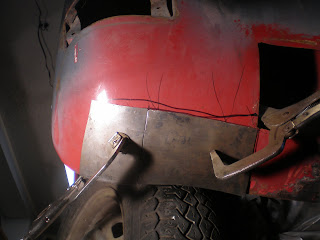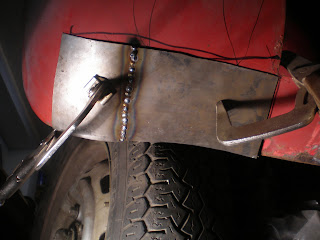While I was at it today, I removed the filler lid and flap release lever from inside the car. I may work a bit on it later today and fill some holes.
I'm not going to make my August 31 deadline for the metal work on the front of the car to be complete, but I am going to be pretty close.
I also ground down the weld on the right headlight... I think I welded that on 7 years ago!!!
 Fender after grinding and sanding the paint off
Fender after grinding and sanding the paint offOn top of trying to get the Karmann Ghia restored, I am training for my first marathon. With an 18 mile run on the menu today, I didn't know whether or not I would get back to the car tonight... Well a nagging case of runner's knee cut my run short by about 12.5 miles. Since I still had a few hours of good energy left, I got back onto the car for a couple quick patches. I filled an area by the spare tire that I burned through with my 7" grinder. I cut out a little patch and welded it up. I also had a patch to install where the right side air vent came through the inner fender. Please don't laugh at the welding. That was the most difficult to reach place I've had to patch. It was done left handed and half blind. I should have welded it from inside the wheel well rather than the luggage area.














































